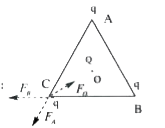Three charges q each are at vertices of equilateral triangle of side r? How much charge should be placed at the centroid so that the system remains in equilibrium?

Due to three identical charges kept at three corners of a triangle, null point (E = 0) is formed at centre 0. Let .Q. be the charge placed at centre of triangle then the charge .Q is in equilibrium.
For system to be in equilibrium the force on each charge must be zero.
Consider the forces on charge at C. Let FA,FBandF0 . be the forces on the charge at .C. due to the charges at A, B and .O. respectively.
FA=FB=14πε0q2a2
Angle between −→FA and −→FB is 60∘
The magnitude of resultant of
−→FAand−→FB=√3×14πε0q2a2
The direction of resultant is along OC.
The force on C due to "Q"is
−→FO=14πε0Qq(a√3)2=3×14πε0Qqa2 (along CO)
The resultant force on charge at C is Zero.
→F=−→FA+−→FB+−→FO=0
sqrt(3) 1/(4 pi epsilon_0) (q^(cancel(2)))/(cancel(r)^2) + (1)/(4 pi epsilon_0) (3Q cancel(q))/(cancel(r)^2) = 0 implies Q = - q/(sqrt(3))
Negative sign indicates that the force −→FO . is opposite to the resultant of −→FA and −→FB.
Similar Questions
Three point charges q are placed on vertices of an equilateral triangle of side length a. The charge Q that should be kept at centroid of triangle such that the system is in equilibrium is equal to
View SolutionFour positive point charges Q are placed at the corners of a square of side a. Calculate the charge that should be placed at the centre so that system remains in equilibrium.
View Solution
Knowledge Check
- Question 1 - Select One
Three point charges + q each are kept at the vertices of an equilateral triangle of side l. Determine the magnitude and sign of charge to be kept at the centroid so that charges at the vertices remain in equillibrium.
AQ=2q√3BQ=q√2CQ=3q√3DQ=q√3 - Question 2 - Select One
Consider three charges q1,q2 and q3 each equal to q, at the vertices of an equilateral triangle of side l. What is the force on a charge Q placed at the centroid of the triangle?
A3Qq4πε0l2B2Qq4πε0l2CQq2πε0l2Dzero - Question 3 - Select One
Three charges each of value q are placed at the corners of an equilateral triangle. A fourth charge Q is placed at the centre of the triangle. If Q=−q:
Athe charges will move towards the centreBthe charges will move away from the centreCthe charges will remain stationaryDthe charges may move in any direction
Four identical charges each .q. are placed at four corners of a square of side .a.. Find the charge to be placed at the centre of the square so that the system of charges is in equilibrium
View SolutionThree charges each of 8 mu C are fixed on vertices of an equilateral triangle of side 1cm. The force on a unit test charge kept at centroid of the triangle will be
View SolutionThree charges of equal magnitude q is placed at the vertices of an equilateral triangle of side l. The force on a charge Q placed at the centroid of the triangle is
View SolutionThree equal charges Q are placed at the three vertices of an equilateral triangle. What should be the va,ue of a charge, that when placed at the centroid, reduces the interaction energy of the system to zero ?
View SolutionThree equal charges Q are placed at the three vertices of an equilateral triangle. What should be the va,ue of a charge, that when placed at the centroid, reduces the interaction energy of the system to zero ?
View Solution

